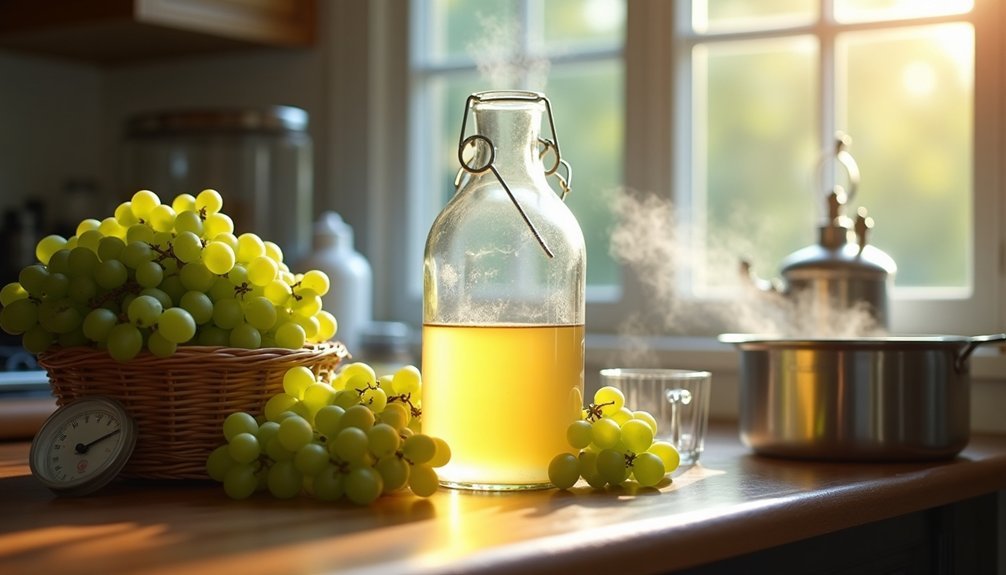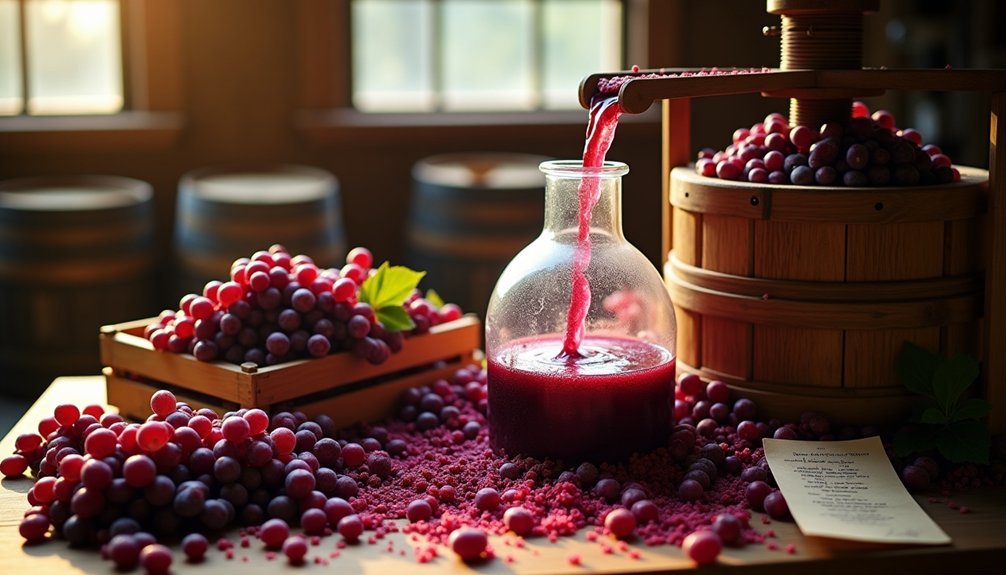I’ve discovered that making white wine at home isn’t just possible—it’s deeply satisfying. There’s something magical about transforming fresh grapes into a crisp, clean beverage that’s entirely your own creation. After years of perfecting my technique, I’m ready to share my step-by-step process for crafting white wine that rivals commercial options but without the preservatives or additives. The secret lies in selecting the right grapes and understanding the fermentation process, which I’ll explain next.
Why You’ll Love This Drink
After spending years perfecting this recipe, I’m confident you’ll fall in love with this homemade white wine. There’s something magical about transforming fresh grapes into a crisp, invigorating beverage right in your own home.
The beauty of this recipe lies in its simplicity and adaptability. You can adjust the sweetness to your preference or experiment with different grape varieties for unique flavor profiles. I’ve designed this method to be accessible even for first-time winemakers.
Unlike commercial wines, your homemade creation contains no preservatives or additives. Plus, there’s an undeniable satisfaction in serving guests a wine you’ve crafted from scratch. The three-month aging process delivers a smooth finish that rivals many store-bought options at a fraction of the cost.
Ingredients
Now that you understand why this homemade wine is worth creating, let’s get to the heart of what you’ll need. My recipe calls for 10 kg of white grapes as your foundation. You’ll also need 1.5 kg of sugar and 1.3 liters of water to create the proper fermentation environment.
For the fermentation magic, I recommend a dedicated winemaking yeast like Universal or Enovini—these are specially formulated for white wines. Don’t skip the 2 grams of pectic enzyme, which breaks down fruit pectin and improves juice extraction.
If you find your wine needs acid adjustment, Kwasomix regulator is optional but helpful. While not listed in ingredients, you’ll also need basic winemaking equipment: a fermentation container, demijohn, and sanitized bottles for the finished product.
Directions
Once you’ve gathered all your ingredients, the winemaking process can begin in earnest. First, separate your grapes from the stems and gently crush them. Place the crushed grapes in your fermentation container, add the pectic enzyme, and mix thoroughly. Cover and let sit for 24 hours.
Next, press the grapes to extract all the juice and transfer it to a demijohn. Prepare a sugar syrup by dissolving your sugar in water, then add this to your grape juice along with the wine yeast. Allow fermentation to proceed for about 4 weeks.
After fermentation completes, carefully decant the wine to remove sediment. This is when I’ll adjust sweetness or acidity if needed. Finally, age your wine for at least 3 months before bottling for best results.
Substitutions and Variations
While the traditional recipe calls for white grapes, you can experiment with several substitutions to create unique variations of homemade white wine. I’ve found that Riesling, Chardonnay, or Muscat grapes each produce distinctive flavor profiles worth trying.
Don’t have winemaking yeast? In a pinch, champagne yeast works well for crisp whites. You can also substitute honey for sugar (use 1.2 kg instead of 1.5 kg) for a mead-like character.
For those avoiding sulfites, ascorbic acid provides an alternative preservative. Consider adding small amounts of complementary fruits like peaches or apricots (about 1 kg) to create fusion wines with complex notes.
If pectic enzyme isn’t available, you can skip it, though you’ll need longer settling time and may notice cloudier wine.
Additional Things to Serve With This Drink
The perfect pairing can elevate your homemade white wine from delightful to unforgettable. I’ve found that light cheeses like brie, goat cheese, or fresh mozzarella complement the crisp profile of homemade whites without overwhelming their delicate flavors.
For a simple gathering, serve your wine with a platter of sliced apples, pears, and seedless grapes alongside unsalted nuts like almonds or cashews. If you’re hosting dinner, consider seafood dishes—grilled shrimp, baked cod, or scallops work beautifully.
Vegetarian options that pair wonderfully include roasted asparagus with lemon, mushroom risotto, or a light pasta primavera. I always keep water crackers on hand for impromptu tastings, allowing guests to cleanse their palates between sips.
Final Thoughts
Making homemade white wine brings me immense satisfaction beyond simply enjoying the finished product. There’s something magical about transforming fresh grapes into a delicious beverage through your own efforts. I find the process connects me to ancient traditions while teaching patience and attention to detail.
Remember that winemaking is both science and art. Don’t be discouraged if your first batch isn’t perfect—each attempt improves your skills. I’ve learned that proper sanitization and temperature control are non-negotiable for success, while aging truly transforms the final product.
If you’ve followed this recipe carefully, you’ll soon enjoy a crisp, personalized white wine that reflects your taste preferences. I’d love to hear how your homemade wine turns out and what variations you might try next!



